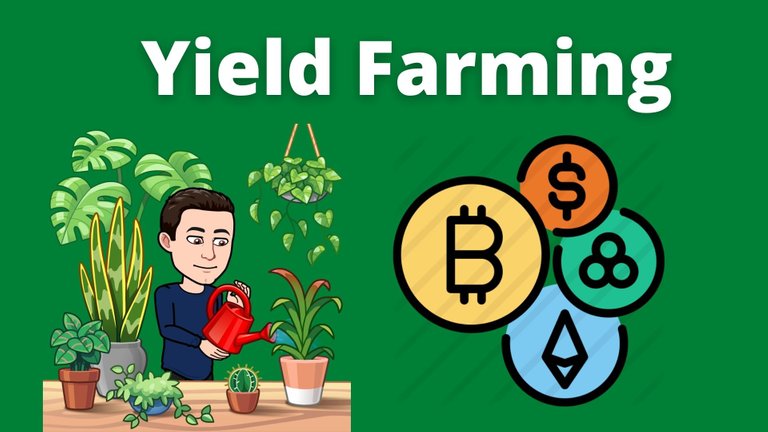Within the cryptographic environment, there are very varied ways to invest our capital to obtain profits and continue making it grow, although the most popular is cryptocurrency trading operations, the appearance of Decentralized Finance (De Fi) brought with it a great variety of financial investment products, which has made them the most popular investment platforms in recent times.

The appearance of MakerDao, Compound Finance, and Uniswap, which later served as the origin of platforms such as Pancakeswap, Sushiswap, or Honeyswap, attracted the attention of investors, with such force, from last year until now, that they have turned the De Fi as the favorite platforms to invest capital with a little less risk and many possibilities of obtaining high returns, this through products such as Stake or Yield Farming.
Do you know what Yield Farming consists of? How could it bring us benefits as investors? Would you like to generate passive income from your cryptocurrencies? Then this publication is for you, let's learn together about this investment modality, how well applied, could represent a very good investment alternative.

What is Yield Farming?
The cultivation of returns is the financial strategy that, based on smart contracts developed by decentralized exchange platforms (DEX), allows investors to enter capital (in the form of cryptographic assets or cryptocurrencies) into the so-called “liquidity pools”, to Obtain passive income in exchange, through the payment of commissions, interest on deposited funds or other benefits that this type of platform can offer.
In essence, this type of operation is very similar to that carried out by banks and financial institutions with the money that is given to them by savers and that they then use to grant loans to third parties, paying an annual interest rate in exchange. for the money kept on deposit. DEXs use “liquidity pools” to provide guaranteed loans to investors who wish to carry out leveraged financial operations or who require liquidity, in cryptocurrencies, for the development of some type of project.

Making the Hodl more productive
When we believe that a certain currency can increase its value in the long term or there is a project that, although it has not yet taken off, we have the feeling that it will be a resounding success, we begin to buy and accumulate them, taking advantage of their low current value and thinking about the future benefits that an increase in value will provide us.
But why wait for the price increase to make a profit if you can do it now? Under this premise, the De Fi offers us the possibility of putting our cryptocurrencies to generate passive income, while we keep it on hodl. The fundamental idea is to “freeze” our assets, in a De Fi, through the use of a smart contract, which allows us to generate rewards for blocked funds, in this way we not only maintain our investment, but also generate additional income.

Benefits of Yield Farming
As we have already discussed, instead of just “hoarding” cryptocurrencies hoping that their value will increase in the long term, we can use them to generate more income, depending on the platform and the “farming” strategy you use, you will be able to “reproduce” your current tokens obtaining income in that same cryptocurrency or you can obtain another type of token as a benefit, which would help you diversify your crypto portfolio.
Although Yield Farming also involves its risks, like any cryptographic investment, the fact that it allows us to obtain passive income by simply holding crypto assets makes it a very desirable investment opportunity and although it requires analysis to determine the liquidity pool or the farming strategy that can provide us with greater profitability, its risk is much lower than trading operations and also involves less effort.

Where and how to do Yield Farming?
Currently, there are many DEX and De Fi that offer this type of investment alternatives, everything will depend on the type of token you want to obtain in exchange, the cryptocurrency you have in possession and even the type of wallet with which you are familiar and safeguard your Cryptoactive, regarding this last point, wallets such as Metamask or TrustWallet are the most popular to be able to interact with the smart contracts that support ERC-20 exchanges.
To be able to carry out Yield Farming operations, simply enter the platform of your interest, locate the liquidity pool that best suits your requirements (you must evaluate the APY or APR offered, as well as the type of reward), connects your wallet, and approve the exchange with the smart contract, do not forget that in addition to the cryptocurrency to be blocked, you will need resources to pay commissions for carrying out these operations.
We keep reading!

Posted Using LeoFinance Beta
I've got a few friends in the USA who are interested in crypto, but both skeptic and intimidated with the learning curve. Your posts would be great reads for them, they are informative, but short and to the point.
Thank you very much @justinparke for the very positive evaluation of my publication, I hope you can contribute in some way so that your friends not only become familiar, but also want to enter even more in this wonderful environment.
Certainly, assimilating some of the concepts and realities that we handle in the blockchain world is not an easy task for those who are used to centralized environments, that is why it is our task to try to explain in the simplest way possible the options with which they can count.
Greetings to your friends, have a beautiful day. ...